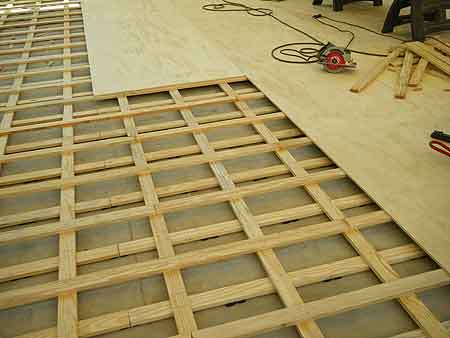Articles and photos by Gregory Havel
At fires and other types of incidents, firefighters sometimes get into trouble because we make incorrect assumptions about the structure that we will be working in or near. These assumptions are frequently based on appearance.
Photo 1 shows a small commercial building that is being remodeled. The exterior was brick, and will remain brick, with a new main entrance. Removal of some of the exterior brick shows that this is not a masonry load-bearing wall, but a wood-frame load-bearing wall with brick veneer. Since this structure was built in the early 1980s, the studs are 2×4 and the sheathing is polyisocyanurate insulating foam board with foil facing. This foam board is combustible, although it should extinguish itself if its ignition source is removed.

(1)
The weight of the masonry above the new entrance will not be supported by the cultured stone lintel that will be installed to cover the foil-faced foam board sheathing. It will be supported by the steel angle that has been lag-screwed through the sheathing into the 2×4 studs. This building appears to have exterior walls of brick masonry. However, all of the loads are carried by combustible wood framing, including the eccentric load of the brick veneer above the doors and windows. The inside of the studs will be finished with gypsum drywall board.
If we assume that this is a “solid brick wall” from its outward appearance, we will be surprised when we are buried under an avalanche of loose brick released by the burning away of the structural supports.

(2)
Photo 2 shows the partially-completed floor in a dance studio attached to a large school auditorium. This building is of non-combustible construction, with masonry load-bearing walls and steel bar-joists supporting a gravel-ballasted insulated membrane roof on a steel roof deck. This building has a complete fire sprinkler system according to National Fire Protection Association Standard 13, Installation of Sprinkler Systems, 2010 edition—except for the combustible space concealed under the dance floor. The dance floor will be seamless vinyl applied to the top of the plywood subfloor; which is supported on three layers of widely-spaced one-inch (25.4 mm) hardwood boards laid at right angles to each other; which are supported by a concrete slab-on-grade.
This type of resilient floor construction is common in gymnasiums, dance studios, and other facilities designed for intense athletic activities. It is used to reduce the possibility of foot, ankle, and knee injuries.
If we become complacent because of the noncombustible structure and the presence of a sprinkler system, we will be surprised when we discover that the space under the floor has provided a channel for fire and smoke travel; or that the fire’s origin was between the finished floor and the concrete subfloor. When our feet, knees, or hands break through and are trapped by a floor of this type, it is too late to remember that we should have used our thermal imaging camera or a sounding tool to locate the hot and weak spots before moving in.
In the absence of a preincident plan that includes information about the construction of the building, it is only safe to assume that the building is not fire-resistive, and that it has many concealed spaces and combustibles.
“Nothing ain‘t ever what it seems.“
– Sergeant Alvin C. York, U.S. Army, World War I, 1887-1964
Download this article as a PDF HERE.
 Gregory Havel Fire Department; retired deputy chief and training officer; and a 30-year veteran of the fire service. He is a Wisconsin-certified fire instructor II, fire officer II, and fire inspector; an adjunct instructor in fire service programs at Gateway Technical College; and safety director for Scherrer Construction Co., Inc. Havel has a bachelor’s degree from St. Norbert College; has more than 30 years of experience in facilities management and building construction; and has presented classes at FDIC.is a member of the Town of Burlington (WI)
Gregory Havel Fire Department; retired deputy chief and training officer; and a 30-year veteran of the fire service. He is a Wisconsin-certified fire instructor II, fire officer II, and fire inspector; an adjunct instructor in fire service programs at Gateway Technical College; and safety director for Scherrer Construction Co., Inc. Havel has a bachelor’s degree from St. Norbert College; has more than 30 years of experience in facilities management and building construction; and has presented classes at FDIC.is a member of the Town of Burlington (WI)

